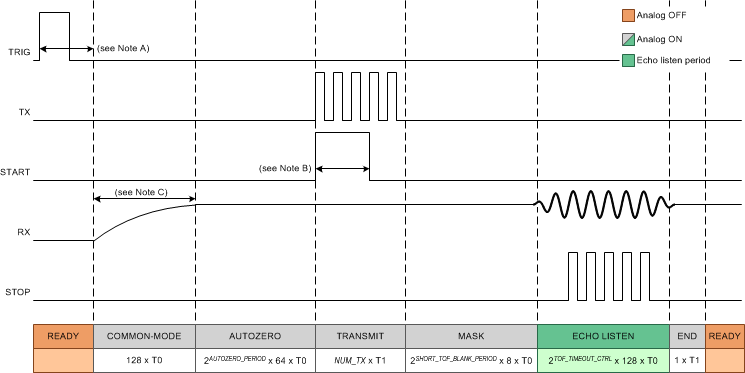SNAS854 February 2023 TDC1000-Q1
PRODUCTION DATA
- 1 Features
- 2 Applications
- 3 Description
- 4 Revision History
- 5 Pin Configuration and Functions
- 6 Specifications
- 7 Parameter Measurement Information
-
8 Detailed Description
- 8.1 Overview
- 8.2 Functional Block Diagram
- 8.3 Feature Description
- 8.4 Device Functional Modes
- 8.5 Programming
- 8.6 Register Maps
- 9 Application and Implementation
- 10Device and Documentation Support
- 11Mechanical, Packaging, and Orderable Information
Package Options
Mechanical Data (Package|Pins)
- PW|28
Thermal pad, mechanical data (Package|Pins)
Orderable Information
8.4.6.1 Short TOF Measurement

In a short time of flight measurement, the RX path is activated before the TX burst, as shown in #SNAS6489966. The input MUX is automatically swapped to the alternate receive channel before and during the TX burst. Swapping the input prevents the TX burst from being amplified in the RX path. After the TX burst, the input MUX remains switched to the alternate channel for a masking period determined by the SHORT_TOF_BLANK_PERIOD field in the TIMEOUT register. Masking the RX path avoids the issue of amplifying the residual TX ringing of the transducer in the RX path.
The short TOF is the default measurement sequence selected at power on. The short TOF measurement is selected if the value of the TIMING_REG[9:0] field is less than 30, or if the FORCE_SHORT_TOF bit is set to 1. The TIMING_REG[9:0] is a 10-bit wide field, with the two most significant bits located in the TOF_1 register, and the eight least significant bits located in the TOF_0 register. The FORCE_SHORT_TOF bit is located in the TIMEOUT register.
The input offset of the comparator is stored in an internal capacitor during the auto-zero period. The length of the auto-zero period is controlled by the AUTOZERO_PERIOD field in the CLOCK_RATE register.
The length of the window when the comparators are able to qualify and generate STOP pulses is configured by the TOF_TIMEOUT_CTRL field. A timeout will occur if the number of expected pulses is not received during the allocated time and an error condition is reported to the ERROR_FLAGS register and the ERRB pin. It is possible to disable the echo timeout (see GUID-4F856601-720B-4A19-A0D9-476CDD03DF8A.html#TITLE-SNAS648SNAS6484784). The TOF_TIMEOUT_CTRL field is located in the TIMEOUT register.
See the GUID-5999259E-0D5F-4478-AB44-452AB0803101.html#TITLE-SNAS648SNAS6488253 section for the definition of the time periods T0 and T1.